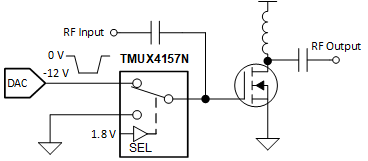SCDS428A March 2020 – March 2021 TMUX4157N
PRODUCTION DATA
- 1 Features
- 2 Applications
- 3 Description
- 4 Revision History
- 5 Pin Configuration and Functions
- 6 Specifications
- 7 Parameter Measurement Information
- 8 Detailed Description
- 9 Application and Implementation
- 10Power Supply Recommendations
- 11Layout
- 12Device and Documentation Support
- 13Mechanical, Packaging, and Orderable Information
Package Options
Mechanical Data (Package|Pins)
- DCK|6
Thermal pad, mechanical data (Package|Pins)
Orderable Information
9.2.1 Negative Voltage Input Control for Power Amplifier
One application of the TMUX4157N is for input control of a power amplifier. Utilizing a switch allows a system to control when the DAC is connected to the power amplifier, and can stop biasing the power amplifier by switching the gate voltage. The ability to dynamically control the power amplifier is beneficial in multiple applications within communication equipment. Figure 9-1 shows the TMUX4157N configured for control of the power amplifier.
 Figure 9-1 Input Control of Power Amplifier
Figure 9-1 Input Control of Power Amplifier